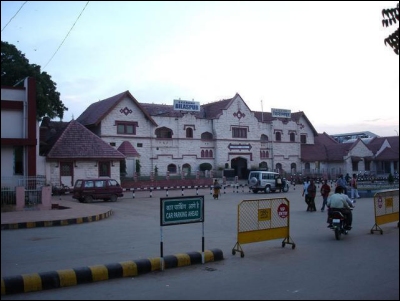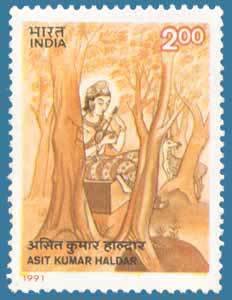|
Jogimara And Sitabenga Caves
The Sitabenga and Jogimara Caves, sometimes referred to either as Sitabenga Cave or Jogimara Cave, are ancient cave monuments nested in the north side of Ramgarh hills in Puta village, Chhattisgarh, India. Dated between the 3rd-century BCE to 1st-century BCE, they are notable for their non-religious inscriptions in Brahmi script and Magadhi language, and one of the oldest colored frescoes in Asia. Some scholars state that the Sitabenga cave is the oldest performance theatre on the Indian subcontinent, but others question whether it was indeed a theatre and suggest that it may have been a resting place (''dharmashala'') along an ancient trade route. The inscription at the Jogimara cave is equally disputed, with one translation interpreting it as a love-graffiti by a girl and a boy, while another translation interpreting it as a female dancer and a male sculptor-painter creating the two caves together to serve others. The inscription is also the oldest known mention of the word "dev ... [...More Info...] [...Related Items...] OR: [Wikipedia] [Google] [Baidu] |
Chhattisgarh
Chhattisgarh (, ) is a landlocked state in Central India. It is the ninth largest state by area, and with a population of roughly 30 million, the seventeenth most populous. It borders seven states – Uttar Pradesh to the north, Madhya Pradesh to the northwest, Maharashtra to the southwest, Jharkhand to the northeast, Odisha to the east, Telangana and Andhra Pradesh to the south. Formerly a part of Madhya Pradesh, it was granted statehood on 1 November 2000 with Raipur as the designated state capital. Chhattisgarh is one of the fastest-developing states in India. Its Gross State Domestic Product (GSDP) is , with a per capita GSDP of . A resource-rich state, it has the third largest coal reserves in the country and provides electricity, coal, and steel to the rest of the nation. It also has the third largest forest cover in the country after Madhya Pradesh and Arunachal Pradesh with over 40% of the state covered by forests. Etymology There are several theories as to the ... [...More Info...] [...Related Items...] OR: [Wikipedia] [Google] [Baidu] |
Brahmi Script
Brahmi (; ; ISO: ''Brāhmī'') is a writing system of ancient South Asia. "Until the late nineteenth century, the script of the Aśokan (non-Kharosthi) inscriptions and its immediate derivatives was referred to by various names such as 'lath' or 'Lat', 'Southern Aśokan', 'Indian Pali', 'Mauryan', and so on. The application to it of the name Brahmi 'sc. lipi'' which stands at the head of the Buddhist and Jaina script lists, was first suggested by T rriende Lacouperie, who noted that in the Chinese Buddhist encyclopedia ''Fa yiian chu lin'' the scripts whose names corresponded to the Brahmi and Kharosthi of the ''Lalitavistara'' are described as written from left to right and from right to left, respectively. He therefore suggested that the name Brahmi should refer to the left-to-right 'Indo-Pali' script of the Aśokan pillar inscriptions, and Kharosthi to the right-to-left 'Bactro-Pali' script of the rock inscriptions from the northwest." that appeared as a fully developed scrip ... [...More Info...] [...Related Items...] OR: [Wikipedia] [Google] [Baidu] |
Ambikapur, India
Ambikapur is a city and headquarters of Surguja district in the Indian state of Chhattisgarh. It is one of the oldest cities in the state, in east-central India. Ambikapur is also the divisional headquarters of Surguja Division which consists of the six districts of Surguja, Korea, Manendragarh, Balrampur, Surajpur and Jashpur. Ambikapur was the capital of the Princely state of Surguja before Indian Independence The name of the city is derived from the Hindu goddess Ambika ( Mahamaya) Devi, who is the central figure of worship in the area. The area under Ambikapur Municipal Corporation is 35.360 sq km. According to Swachh Survekshan 2019, Ambikapur was the second Cleanest cities of India. As of Swachh Survekshan 2020, Ambikapur is the cleanest city of Chhattisgarh as well as the cleanest city in India amongst cities with a population of 1 to 10 lakhs. Geography Ambikapur is located at . It has an average elevation of 623 metres (2078 feet). The district is spread ... [...More Info...] [...Related Items...] OR: [Wikipedia] [Google] [Baidu] |
Bilaspur, Chhattisgarh
Bilaspur, also known as "The City of Festivals", is a city located in Bilaspur District in the Indian state of Chhattisgarh. Bilaspur is the Administrative headquarters of the Bilaspur District and Bilaspur Division. The Chhattisgarh High Court, located at Bodri, District Bilaspur has privileged it with the title ''Nyayadhani'' (Law Capital) of the State. This city is the commercial center and business hub of North East Chhattisgarh region. It is also an important city for the Indian Railways, as it is the headquarters for South East Central Railway Zone (SECR) and the Bilaspur Railway Division. Bilaspur is also the headquarters of South Eastern Coalfields Limited. Chhattisgarh biggest power plant operated by NTPC is in Sipat. PowerGrid in Sipat pools electricity from other power plants in region and transmits electricity to Delhi via one of longest HVDC line. Bilaspur is known for its aromatic rice variety named ‘Doobraj’ rice, Handloom woven colourful soft Kosa sil ... [...More Info...] [...Related Items...] OR: [Wikipedia] [Google] [Baidu] |
Heinrich Lüders
Heinrich Lüders (25 June 1869 in Lübeck – 7 May 1943 in Badenweiler) was a German Orientalist and Indologist known for his epigraphical analysis of the Sanskrit Turfan fragmentary manuscripts. Biography From 1888 to 1894, he studied at the universities of Munich and Göttingen, and afterwards worked as an assistant curator and librarian in the Indian Institute at Oxford University. In 1898, he became an associate professor at Göttingen, then five years later relocated to Rostock, where in 1905 he was named professor of Indo-European linguistics and Sanskrit. In 1909, he was appointed professor of ancient Indian languages and literature at the University of Berlin, where in 1931–32 he served as academic rector. In 1935, he retired from teaching and devoted himself entirely to research.Lüders, Heinrich Catalogus Professorum Rostochien ... [...More Info...] [...Related Items...] OR: [Wikipedia] [Google] [Baidu] |
Udayagiri And Khandagiri Caves
Udayagiri and Khandagiri Caves, formerly called Kattaka Caves or Cuttack caves, are partly natural and partly artificial caves of archaeological, historical and religious importance near the city of Bhubaneswar in Odisha, India. The caves are situated on two adjacent hills, Udayagiri and Khandagiri mentioned as ''Kumari Parvata'' in the Hathigumpha inscription. They have a number of finely and ornately carved caves built during the 1st century BCE. It is believed that most of these caves were carved out as residential blocks for Jaina monks during the reign of King Kharavela. Udayagiri means "Sunrise Hill" and has 18 caves while Khandagiri has 15 caves. The caves of Udayagiri and Khandagiri, called ''lena'' or ''leṇa'' in the inscriptions, were dug out mostly during the reign of Kharavela for the abode of Jaina ascetics. The most important of this group is Ranigumpha in Udayagiri which is a double storeyed monastery. Other important caves include Hathi Gumpha, Ananta Gumpha ... [...More Info...] [...Related Items...] OR: [Wikipedia] [Google] [Baidu] |
Asit Kumar Haldar
Asit Kumar Haldar (10 September 1890 – 13 February 1964) was an Indian painter of Bengal school and an assistant of Rabindranath Tagore at Shantiniketan. He was one of the major artists of the Bengal renaissance. Early life Haldar was born in Jorasanko in 1890. His maternal grandmother was the sister of Rabindranath Tagore, making him Tagore's grandnephew. Both his grandfather Rakhaldas Haldar and his father Sukumar Haldar were accomplished in the art of painting.Teacher of the Artist - Sanat Art Gallery He began his studies at the age of 14. His education was undertaken at Government School of Art, and began in 1904. Haldar learned sculpting from two famous |
Chitra (art)
Chitra, also spelled as Citra, is an Indian genre of art that includes painting, sketch and any art form of delineation. The earliest mention of the term ''Chitra'' in the context of painting or picture is found in some of the ancient Sanskrit texts of Hinduism and Pali texts of Buddhism. Nomenclature ''Chitra'' (IAST: ''Citra'', चित्र) is a Sanskrit word that appears in the Vedic texts such as hymns 1.71.1 and 6.65.2 of the ''Rigveda''. There, and other texts such as ''Vajasaneyi Samhita'', ''Taittiriya Samhita'', ''Satapatha Brahmana'' and ''Tandya Brahmana'', ''Chitra'' means "excellent, clear, bright, colored, anything brightly colored that strikes the eye, brilliantly ornamented, extraordinary that evokes wonder". In the ''Mahabharata'' and the ''Harivamsa'', it means "picture, sktech, dilineation", and is presented as a genre of ''kala'' (arts). Many texts generally dated to the post-4th-century BCE period, use the term ''Chitra'' in the sense of painting, and ''Chi ... [...More Info...] [...Related Items...] OR: [Wikipedia] [Google] [Baidu] |
Caves Of Chhattisgarh
A cave or cavern is a natural void in the ground, specifically a space large enough for a human to enter. Caves often form by the weathering of rock and often extend deep underground. The word ''cave'' can refer to smaller openings such as sea caves, rock shelters, and grottos, that extend a relatively short distance into the rock and they are called ''exogene'' caves. Caves which extend further underground than the opening is wide are called ''endogene'' caves. Speleology is the science of exploration and study of all aspects of caves and the cave environment. Visiting or exploring caves for recreation may be called ''caving'', ''potholing'', or ''spelunking''. Formation types The formation and development of caves is known as ''speleogenesis''; it can occur over the course of millions of years. Caves can range widely in size, and are formed by various geological processes. These may involve a combination of chemical processes, erosion by water, tectonic forces, microorgani ... [...More Info...] [...Related Items...] OR: [Wikipedia] [Google] [Baidu] |
Indian Inscriptions
The earliest undisputed deciphered epigraphy found in the Indian subcontinent are the Edicts of Ashoka of the 3rd century BCE, in the Brahmi script. If epigraphy of proto-writing is included, undeciphered markings with symbol systems that may or may not contain linguistic information, there is substantially older epigraphy in the Indus script, which dates back to the early 3rd millennium BCE. Two other important archeological classes of symbols are found from the 1st millennium BCE, Megalithic graffiti symbols and symbols on punch-marked coins, though most scholars do not consider these to constitute fully linguistic scripts, and their semiotic functions are not well understood. Writing in Sanskrit (Epigraphical Hybrid Sanskrit, EHS) appears in the 1st to 4th centuries CE. Indian epigraphy becomes more widespread over the 1st millennium, engraved on the faces of cliffs, on pillars, on tablets of stone, drawn in caves and on rocks, some gouged into the bedrock. Later th ... [...More Info...] [...Related Items...] OR: [Wikipedia] [Google] [Baidu] |

.png)





_(13888446659).jpg)

